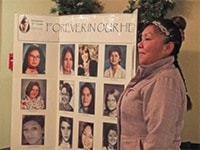About 90 people attended the day-long symposium co-hosted by the Ministry Transportation and Infrastructure and the First Nations health authority last week.
Although transportation minister Todd Stone did not attend symposium, he has promised to turn discussions into action.
“We’re now going to turn the discussions into action and to work on a plan that provides an effective model for transportation along the highway as quickly as possible,” said Stone in a press release issued after the event.
The goal of the transportation symposium was to address transportation challenges and find ways to improve services along Hwy. 16 between Prince Rupert and Prince George. At least 18 women have been murdered or gone missing along 800-km stretch of road known as the highway of tears.
Mary Teegee from Carrier Sekani Family Services was cautiously optimistic that this meeting was a step towards seeing improvements.
“The government says that they are committed to dealing with this issue; I'm not going to hold my breath, but I am hopeful,” she said.
Her organization also runs the highway of tears initiative, which provides advocacy and support for vulnerable women and families of victims.
“The number one recommendation in the highway of tears recommendations is to have a shuttle bus and to develop a transportation system; I did bring that forward and I was hoping that there was going to be resources for that... that hadn't been identified or announced [before].”
The idea of a shuttle bus service connecting communities along the highway of tears is not a new topic. The idea was first put forward at a symposium in Prince George in early 2000, according to Cheslatta Carrier Nation Chief Corrina Leween.
“To this day, it has not been implemented and no funding has been allocated yet; hence hitchhiking continues,” said Leween.
The ministry has ruled out a shuttle bus service. Instead the ministry says it will focus on “community-based” transportation solutions which are suited to individual communities along the highway.
Examples of what that might look like were presented at the symposium. Among the models discussed were Northern Health's medical transportation bus, a community-led service in Lake Babine, and the seniors helping seniors program in Fort St. James.
First Nations chiefs in the Burns Lake area - including Lake Babine Nation chief Wilf Adam, Wet’suwet’en First Nation chief Karen Ogen and Burns Lake Band chief Dan George - said they were not able to attend the symposium.
Burns Lake Mayor Luke Strimbold was the only participant representing the Village of Burns Lake.
Strimbold said the symposium was a “great opportunity for everyone to spend time together focusing on solutions for transportation.”
“We heard survey results that provided some insight into the needs; we heard from organizations that have effective transportation models in their community; and we also had break-out sessions to work through ideas that may work in each of the different regions,” he said.
Although participants did not decide on a permanent solution during the symposium, Strimbold said they identified a “next step.”
“We believe we need to have a more in-depth regional discussion with First Nation leaders, local government leaders, ministry staff, and staff from the various agencies that influence the use of transportation,” he said. “We need to identify all existing transportation programs and identify opportunities to make current programs more efficient.”
“We have an opportunity to think outside the box and come up with creative solutions that pool our resources,” he added.
– With files from Alicia Bridges, Smithers Interior News
